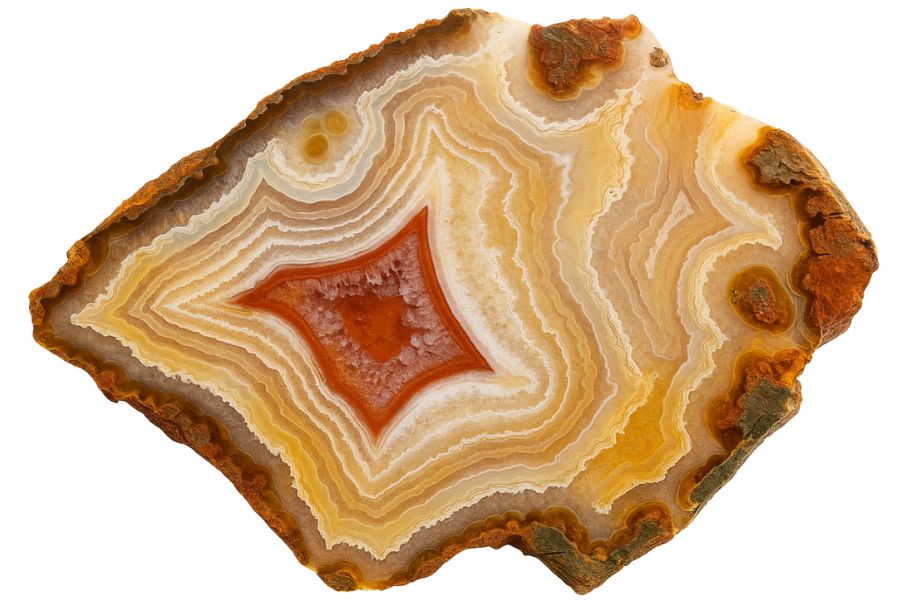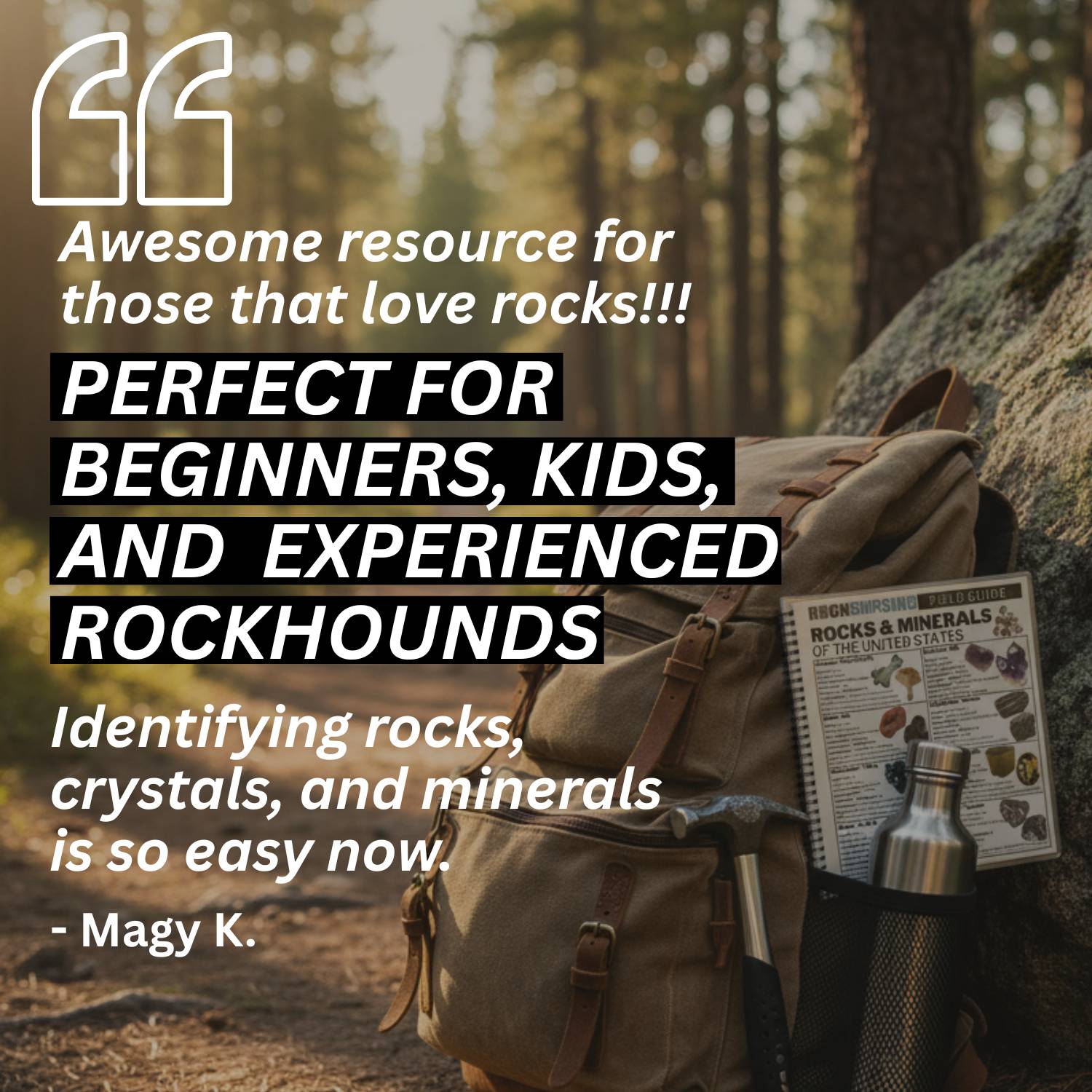Finding agates in North Dakota is easier than you might think with a surprising history of gemstone discoveries in the state. The state’s past is tied to immense glaciers that scoured the landscape and deposited a rich variety of materials from far away.
This legacy has left a subtle but rewarding trail of agates scattered across the plains and into the state’s waterways.
A successful search often involves looking where these glacial deposits have been disturbed, like in riverbeds and gravelly hillsides. The agates often stand out from the surrounding rock with their unique colors and banded patterns.
We can point you toward the areas of North Dakota where agates appear most often and guide you on what signs to watch for. With a bit of direction and a patient eye, you will be able to begin and grow a beautiful collection of stones that stand out from the rest.
What is North Dakota Agate?
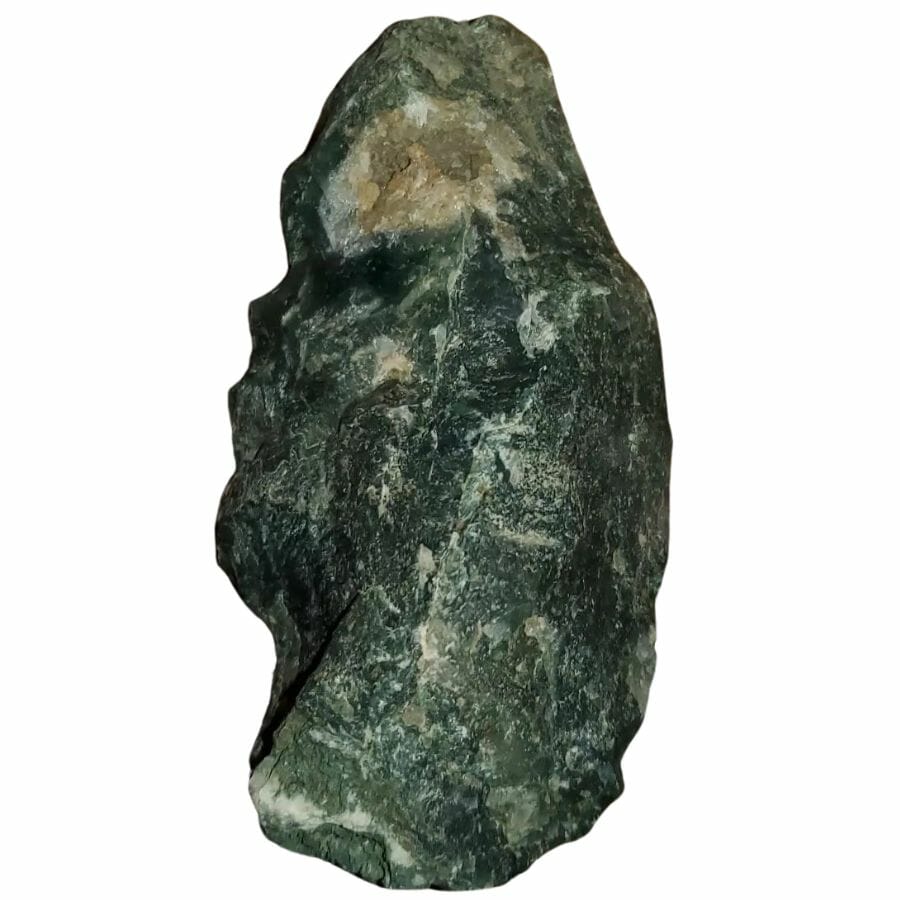
Agates are one of nature’s most dazzling wonders. They’re colorful, banded rocks formed mostly of chalcedony. Imagine a rainbow trapped inside a rock– that’s what some agates look like!
The beautiful bands and patterns you see inside this gem are made over millions of years. When hot volcanic lava cools and hardens, it leaves behind tiny spaces. Over time, water filled with minerals drips into these spaces and slowly builds up in layers.
With its beauty, it’s not surprising that agate’s value can go through the roof in some cases. More so, this gem is found all over the world! They often show up in volcanic areas and riverbeds, where the magic of their creation took place.
If you’re in North Dakota, you’re in luck because agates are abundant here. While our state might be better known for its plains, it’s a hidden gem (pun intended!) for agate hunters.
But before we guide you on how to find agate in North Dakota, let’s first go through the different types of agates and if you can find them here:
Blue Lace Agate
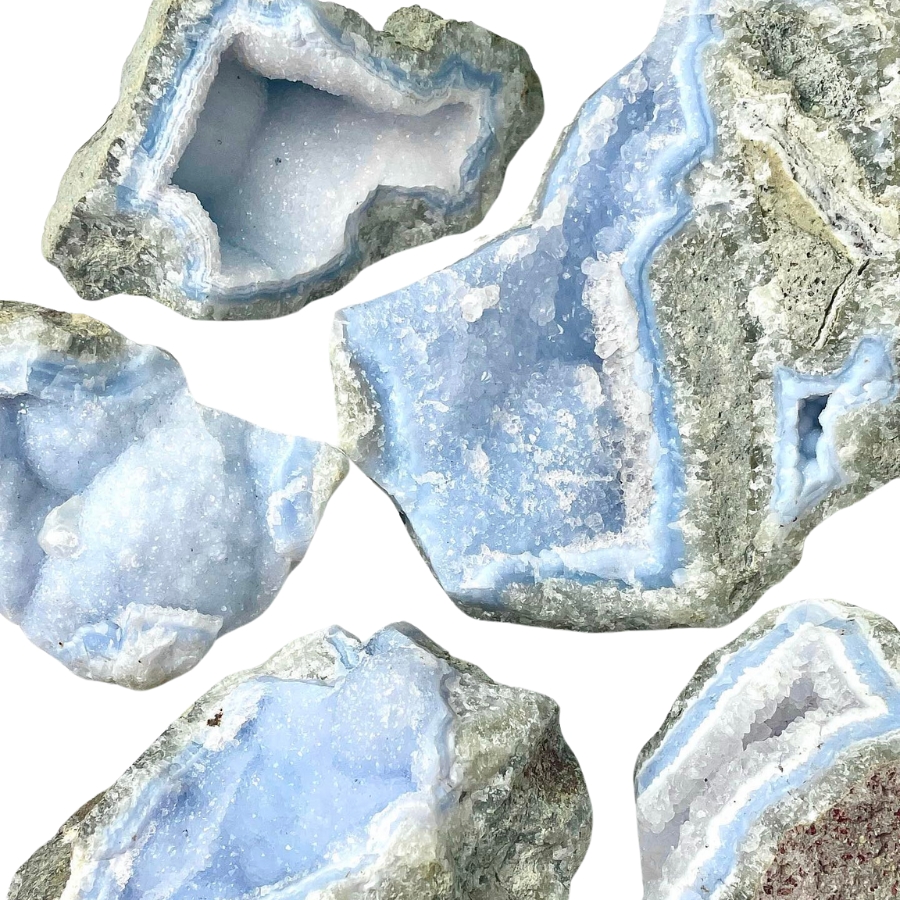
Blue lace agate is like the soft, sky-blue waves with lines that swirl and twist like delicate lace.
Its pattern comes from slow-forming layers of quartz, which create those beautiful, lace-like bands.
The bands of this agate type are often in shades of light blue, white, and sometimes a bit of grey. It’s different from other agates, which usually have more intense colors and stronger patterns.
The value of blue lace agate lies in its soft, tranquil look and the feeling of calm it brings. It’s often used in jewelry or as a decorative stone.
If you want REAL results finding incredible rocks and minerals you need one of these 👇👇👇
Finding the coolest rocks in isn’t luck, it's knowing what to look for. Thousands of your fellow rock hunters are already carrying Rock Chasing field guides. Maybe it's time you joined the community.
Lightweight, mud-proof, and packed with clear photos, it’s become the go-to tool for anyone interested discovering what’s hidden under our red dirt and what they've already found.
Join them, and make your next rockhounding trip actually pay off.
What makes it different:
- 📍 Find and identify 140 incredible crystals, rocks, gemstones, minerals, and geodes across the USA
- 🚙 Field-tested across America's rivers, ranchlands, mountains, and roadcuts
- 📘 Heavy duty laminated pages resist dust, sweat, and water
- 🧠 Zero fluff — just clear visuals and straight-to-the-point info
- ⭐ Rated 4.8★ by real collectors who actually use it in the field
Moss Agate
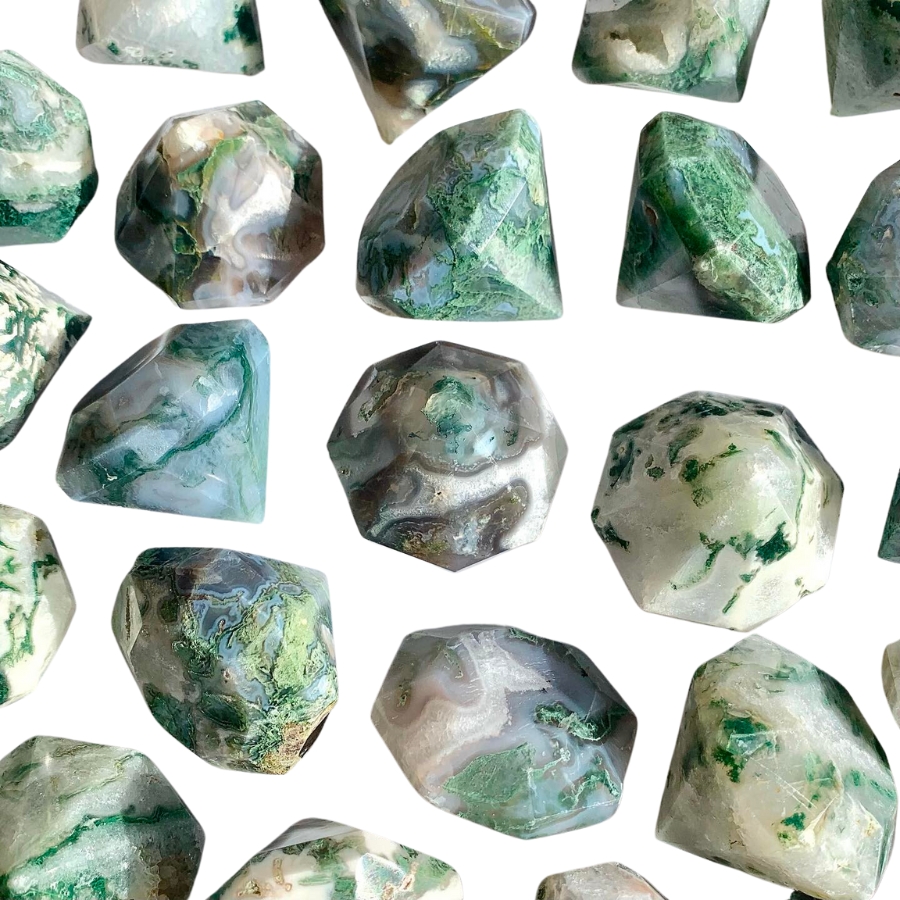
Instead of having the typical banding for which the different types of agates are known, moss agate has green inclusions that look like moss or trees.
These green patterns aren’t real plant material, though. They’re minerals like chlorite or iron oxide.
In some cultures, this type of agate is known as the “gardener’s stone” because of its green, plant-like appearance. It’s believed to help plants grow.
The price of moss agate can vary. It’s often quite affordable, but the more distinct and picturesque the green patterns, the more it might cost.
Fire Agate
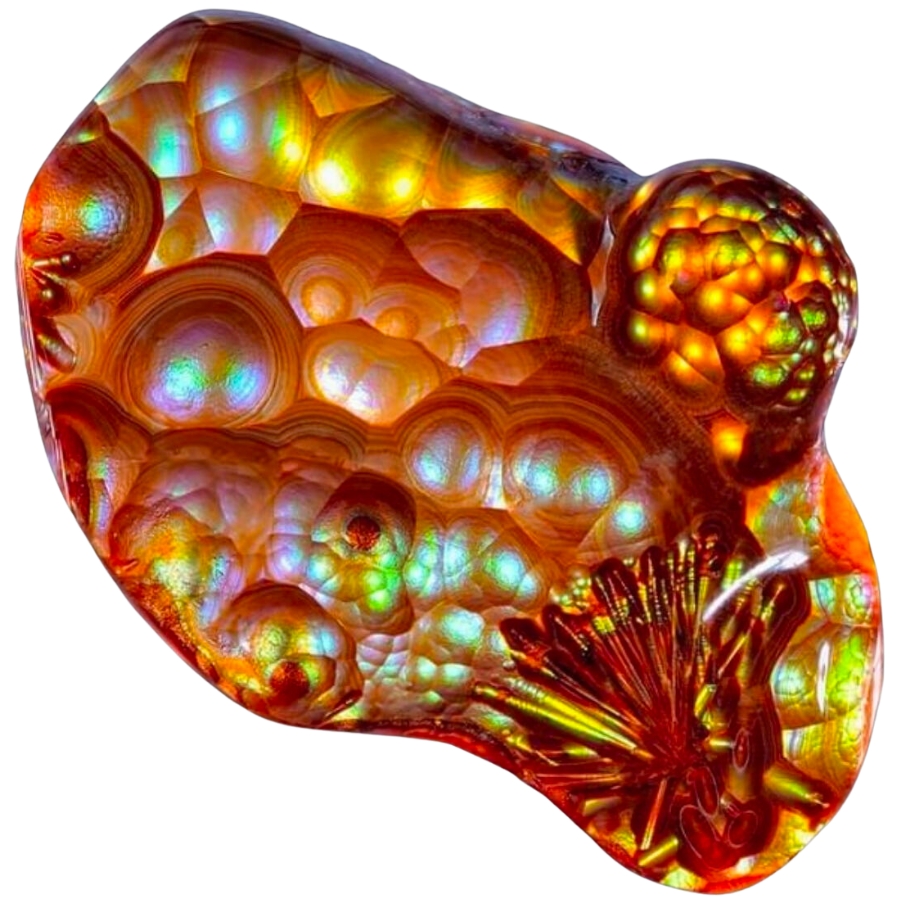
Fire agate is known for its incredible colors and the way it sparkles like fire. It’s got layers of silica and iron oxide that reflect light, creating a fiery effect.
When you look at fire agate, it’s like seeing flames trapped inside. Its colors can range from reds and oranges to greens and golds, all shimmering under the surface.
You might be wondering, “What is fire agate worth?” Well, its value comes from its rare beauty. The more color and sparkle, the more valuable the stone is.
Its fiery iridescence and lively play of color are used in jewelry pieces that are meant to stand out.
Dendritic Agate
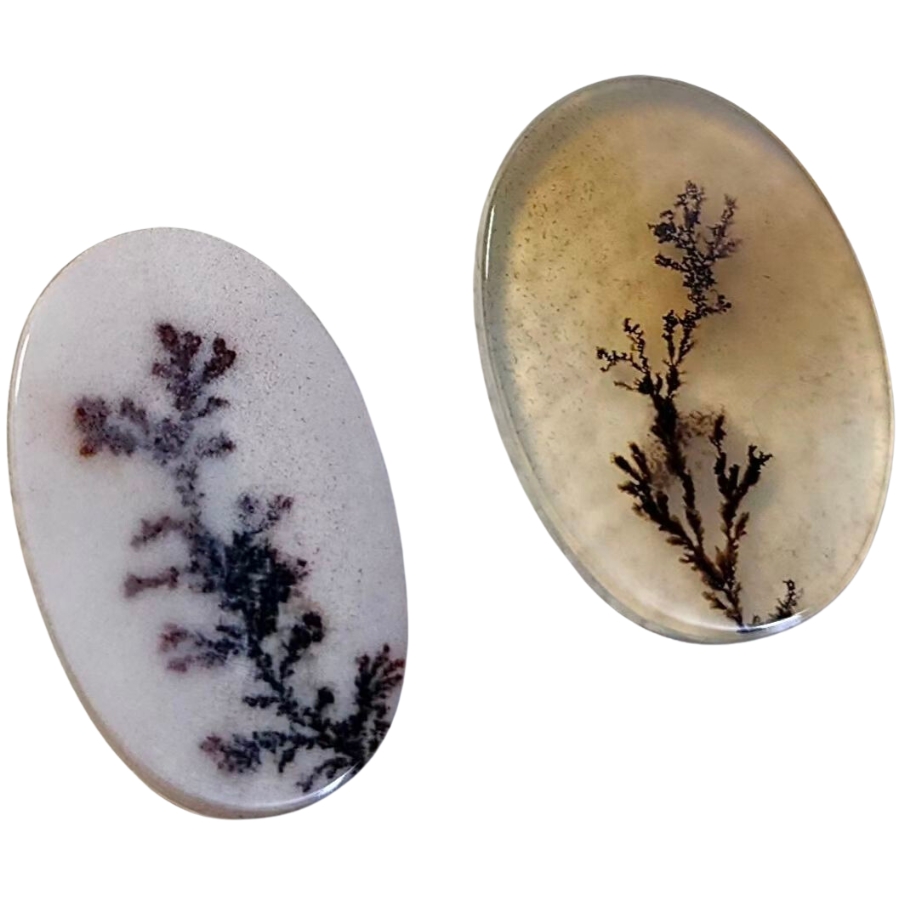
Dendritic agate is known for patterns that look like tiny trees or shrubs. Like moss agate, these patterns aren’t actual plants. They’re made of minerals, mostly manganese or iron oxides.
When you look at a dendritic agate, it’s like peering into a miniature forest or a frosty winter landscape.
The base of the stone is usually translucent to opaque, and the “dendrites”— those tree-like patterns— are often black or brown.
When it comes to how much dendritic agate is worth, it can vary. The more detailed and distinct the patterns are, the more it’s usually valued.
In some cultures, dendritic agate is believed to bring fullness and richness to life.
Crazy Lace Agate
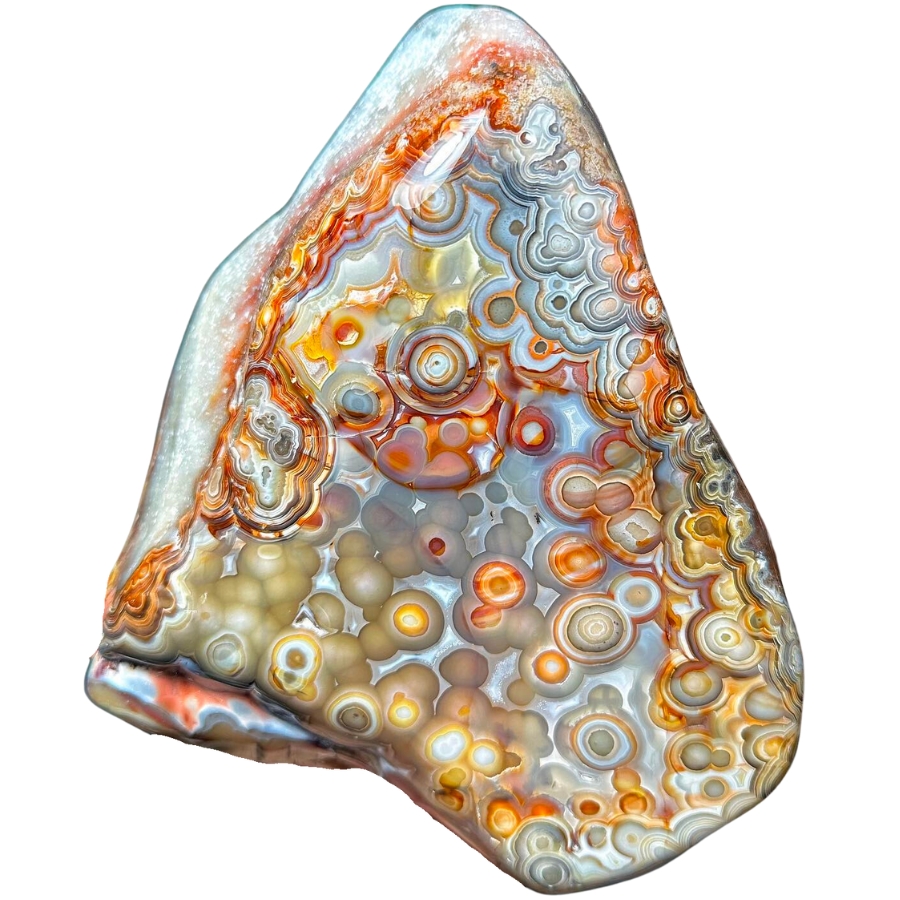
Crazy lace agate is like a party in a rock! It’s got swirls, circles, and all sorts of wild patterns dancing across it.
Its colors can be a mix of red, orange, yellow, and brown, and sometimes even a bit of gray or white.
What makes crazy lace agate stand out is its vibrant and complex patterns. No two pieces are the same. This distinctiveness is a big reason why it’s so valued.
Despite its wild and ‘crazy’ appearance, it’s sometimes called the “Laughter Stone” or “Happy Lace” because of the joy and positive vibes it’s believed to bring.
Laguna Agate
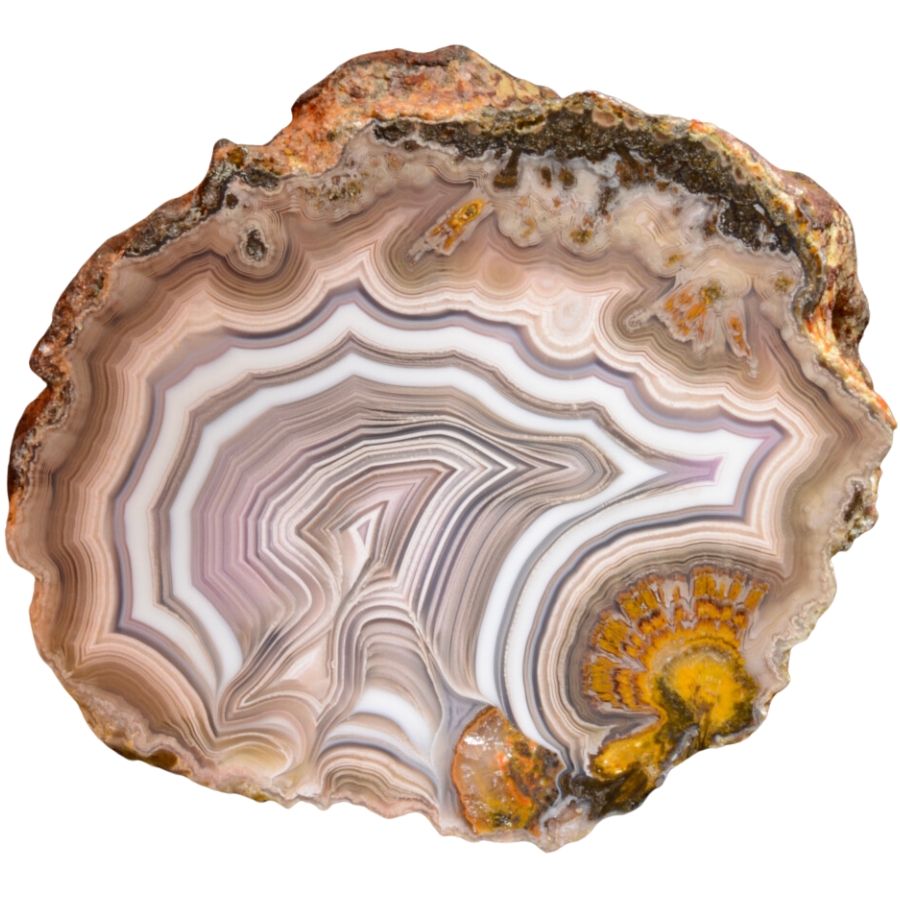
Laguna agate has incredibly sharp and fine banding. It has layers of red, orange, pink, yellow, and sometimes even purple and white all stacked in neat, tight bands.
These bands can form eye-catching patterns, like swirls, loops, and even landscapes.
The different colors of its bands come from various minerals present in the water at the time of its formation.
Laguna agate is considered one of the finest agates in the world due to its exceptional banding. This high regard among agate varieties makes it a prized possession for collectors.
Condor Agate
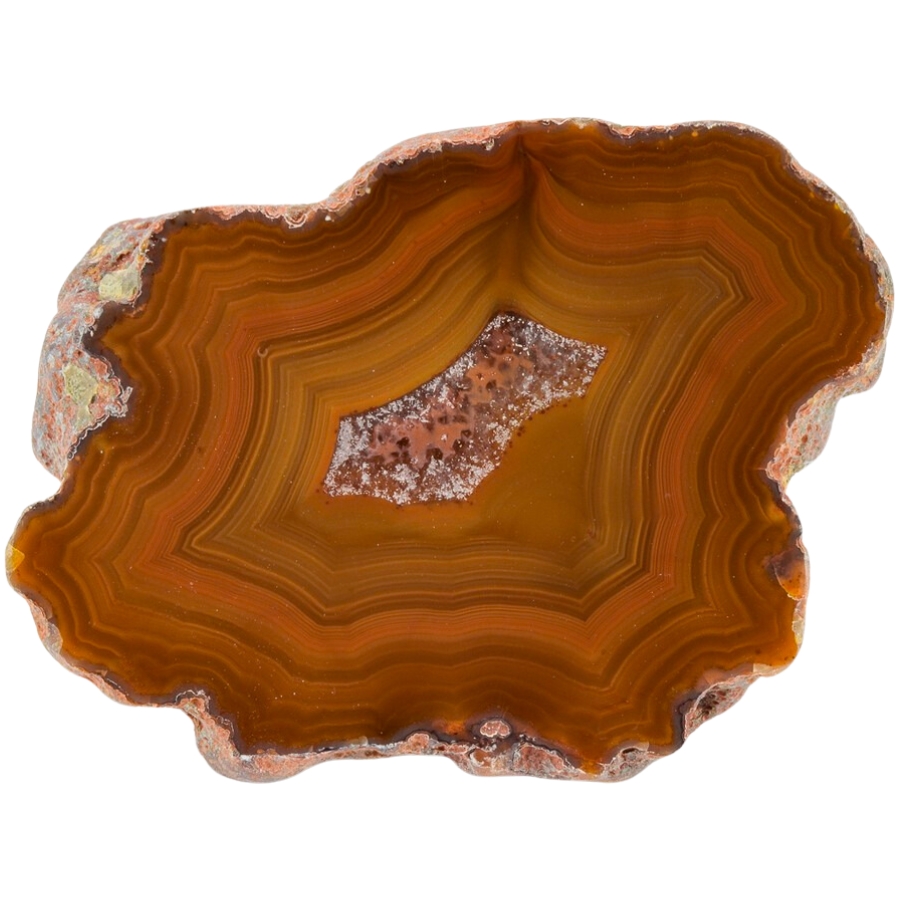
Condor agate is a real standout. It’s known for its bright, vivid colors and complex patterns.
It has reds, oranges, yellows, and sometimes even blues and greens all swirling together. These colors form in bands or in more random, artistic patterns.
The intensity and variety of its colors is what makes condor agate so special. It’s often used by artists and craftsmen who want to make a statement with their work.
Condor agate’s bold colors and patterns can turn a simple piece of jewelry or art into something really eye-catching.
Fortification Agate (Banded Agate)
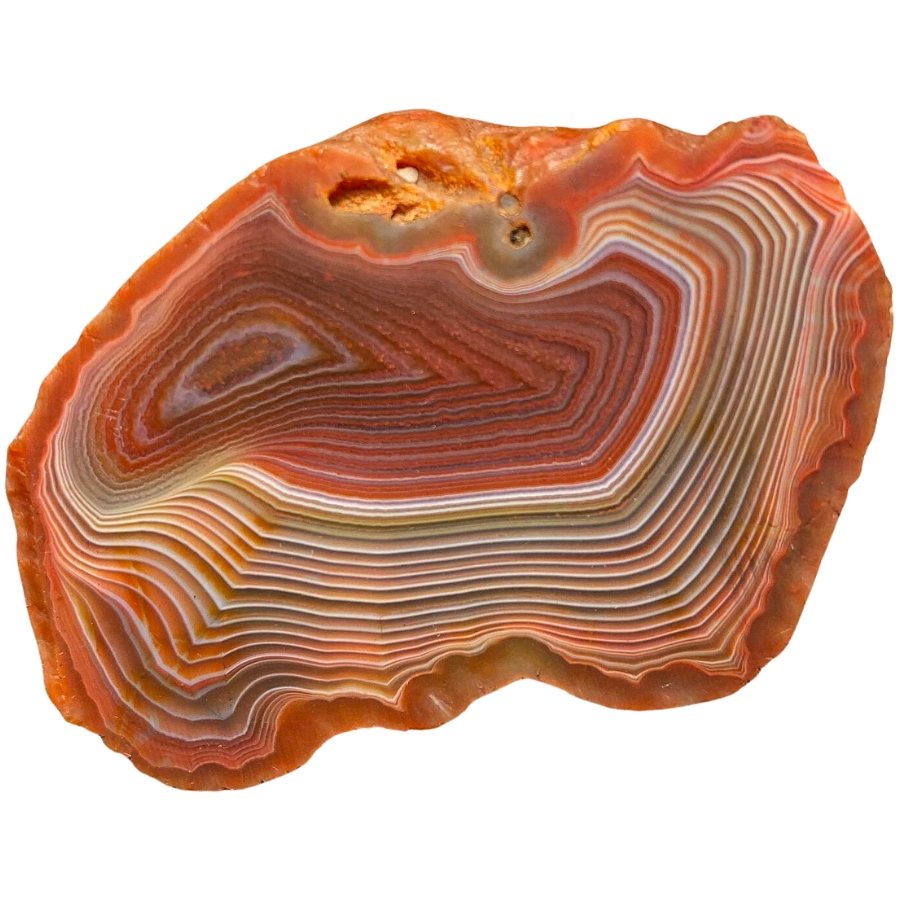
Fortification agate gets its name because the patterns inside it look like the aerial view of a fortified city.
Imagine seeing bands of color forming shapes that look like walls, with sharp angles and curves. They are usually in different colors, making each layer stand out.
If fortification agate is valuable, it’s because of its distinct patterns and colors. Its unique look makes it sought after for jewelry and as a collector’s item.
The clearer and more defined the patterns, the more valuable the stone can be. Some people also believe it can help with relaxation and calmness.
Iris Agate
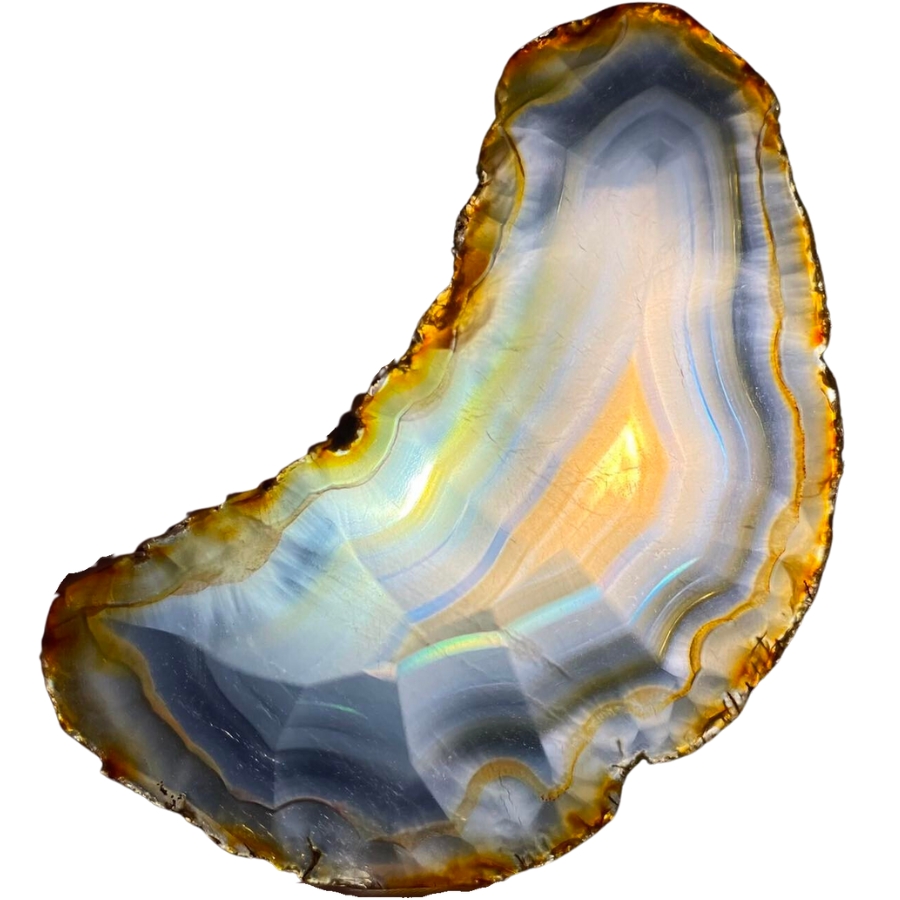
Iris agate looks like a regular agate at first, but when you hold it up to the light, something amazing happens. It shows all these rainbow colors, like light passing through a prism.
This is because it has very thin layers of silica, and when light hits these layers, it splits into all the colors of the rainbow.
The formation of iris agate is similar to other agates, but its layers are super thin, which is what creates the rainbow effect.
The value of iris agate comes from its unique ability to show these colors. In the past, people even used to think it had magical properties because of the way it showed colors. They saw it as a stone of good luck and wonder.
Plume Agate
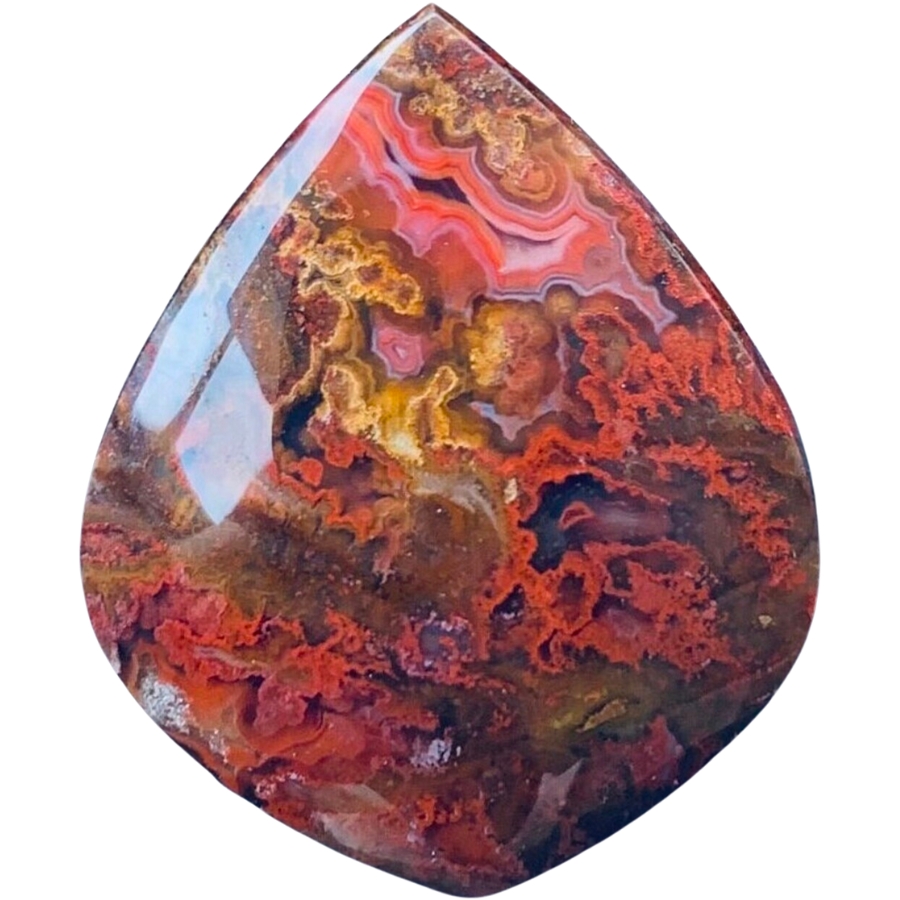
Plume agate gets its name from its patterns that look like soft, feathery plumes. These plumes can be in all sorts of colors: red, black, green, or yellow, set against a translucent or opaque background.
The way these plumes seem to float in the stone makes it look like a frozen underwater scene or like feathers caught in a breeze.
The plumes are made of minerals like manganese or iron oxide, which get trapped in the silica during the agate’s formation and create the feathery patterns.
The price of plume agate can vary depending on how clear and intricate the patterns are. The more detailed and colorful the plumes, the more the stone is usually worth.
Picture Agate (Scenic Agate)
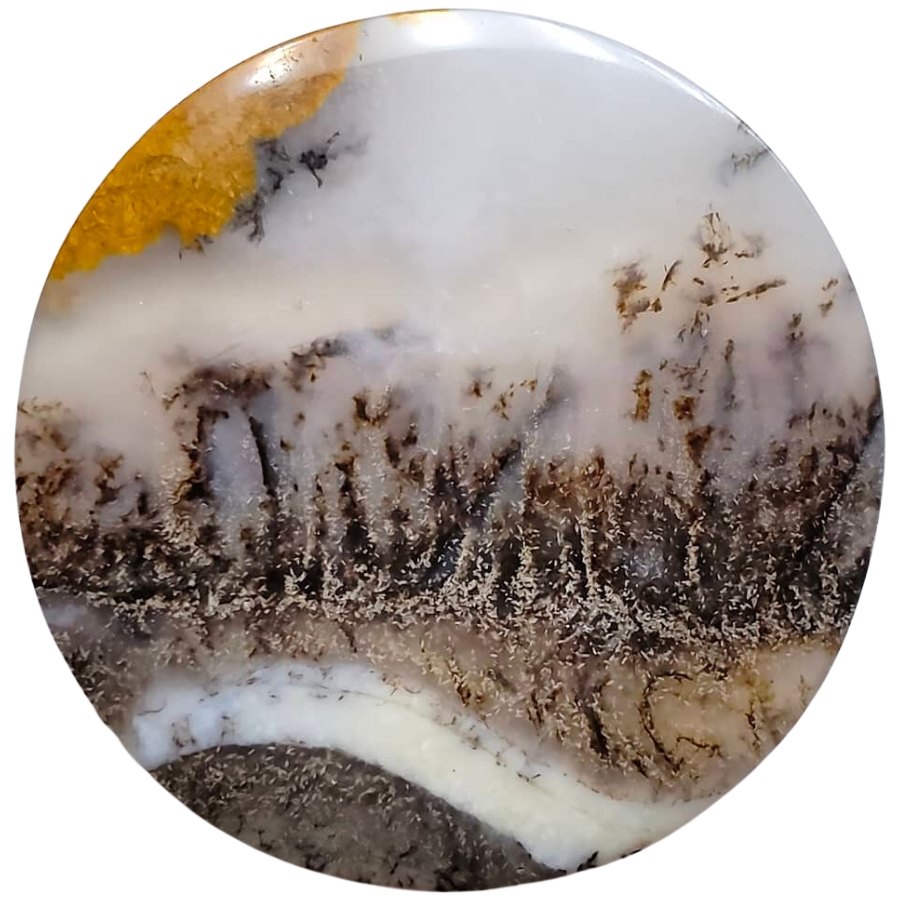
Picture agate is like a snapshot of nature captured in stone because it looks like it has pictures or scenes right inside it.
These “pictures” are actually natural patterns that resemble landscapes, mountains, trees, or even skies. They are usually in different shades of brown, white, and gray against a more translucent background.
The different patterns in picture agate or what’s also called scenic agate are made by various minerals in the water filled with silica that forms it.
If you’re thinking, “What is picture agate worth?“, its value comes from how distinct, clear, and detailed the natural “pictures” are.
Turritella Agate
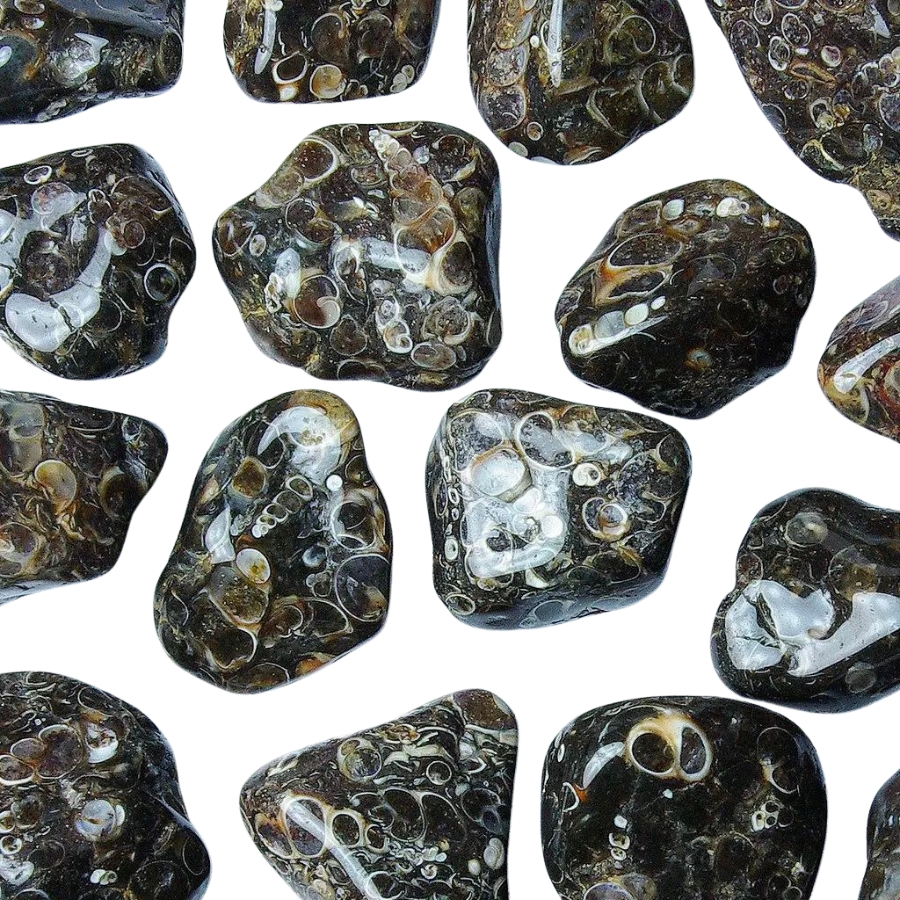
Turritella agate is not your typical agate because it’s full of fossilized snail shells! The shells belong to a creature called Turritella, a type of sea snail.
These shells are tightly packed and create a pattern that looks like a bunch of tiny, swirling towers. The background of the agate is usually a dark, earthy color, which makes the white or cream-colored snail shells really pop.
Over millions of years, these snail shells got buried in sediment and eventually became fossilized. As time went on, silica-rich water flowed through the sediment, turning it into the agate we see today.
The value of turritella agate comes from its unique blend of geology and history. More than a pretty stone, it’s a piece of ancient life preserved in rock.
Fairburn Agate
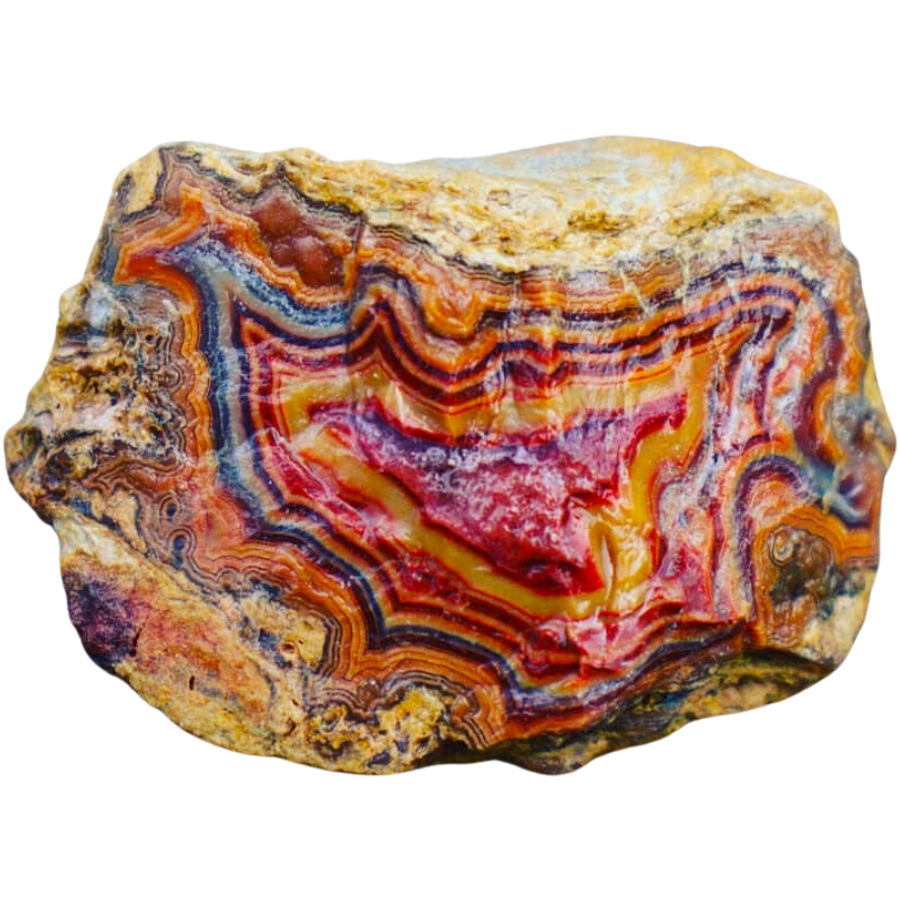
Known for its intricate patterns and bold colors, Fairburn agate is another fascinating type of agate. It usually has bands and swirls of different colors like red, yellow, orange, brown, and sometimes even pink or purple.
What’s special about these patterns is they often look like they’re in layers, creating a 3D effect. It’s like looking at a landscape made of stone.
It’s named after a place called Fairburn in South Dakota. This gives a clue about where it was first discovered.
People value Fairburn agate for the skill it takes to cut and polish it, which makes the patterns and colors really stand out.
Sagenite Agate
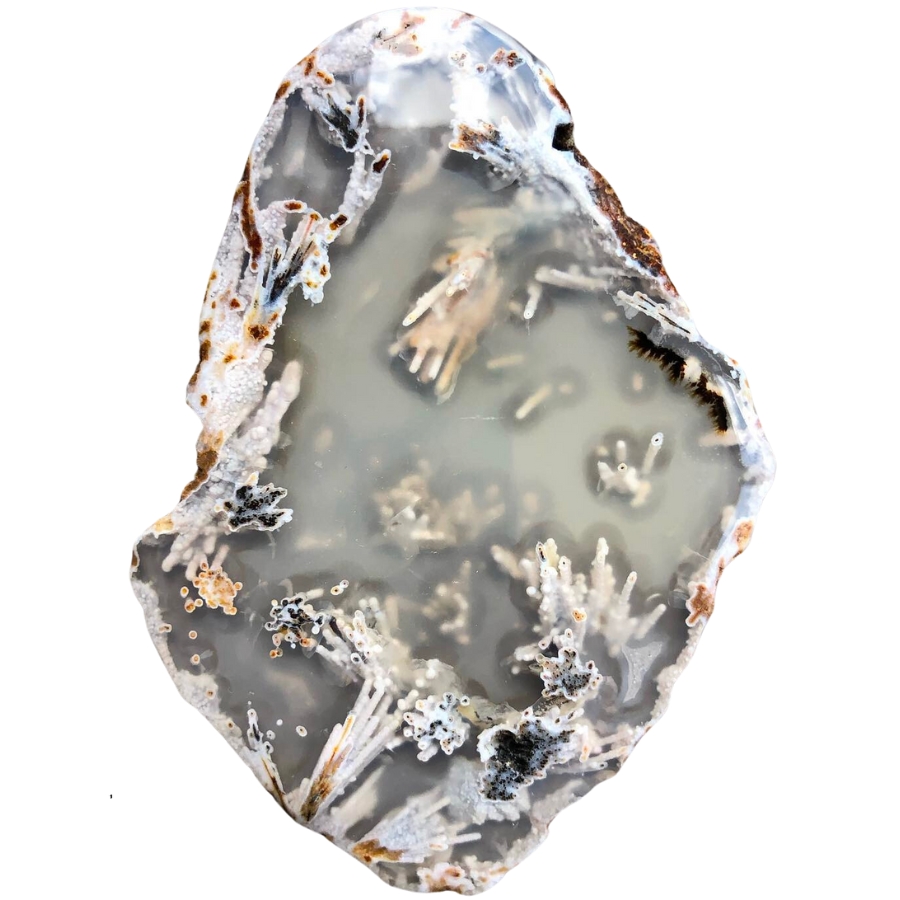
Sagenite agate has needle-like inclusions that look like tiny sprays of crystals inside it. They can be gold, silver, black, or even green, and they spread out in all directions, creating an amazing pattern.
The base of the agate is usually translucent, which lets you see these intricate needle patterns clearly.
These patterns are actually other minerals, like rutile or goethite, that get trapped inside the forming agate. These minerals grow in a crystal shape, looking like needles or hair.
Sagenite agate is often used in jewelry and other decorative items, with some people thinking that its needle patterns look like fireworks or starbursts.
Tree Agate
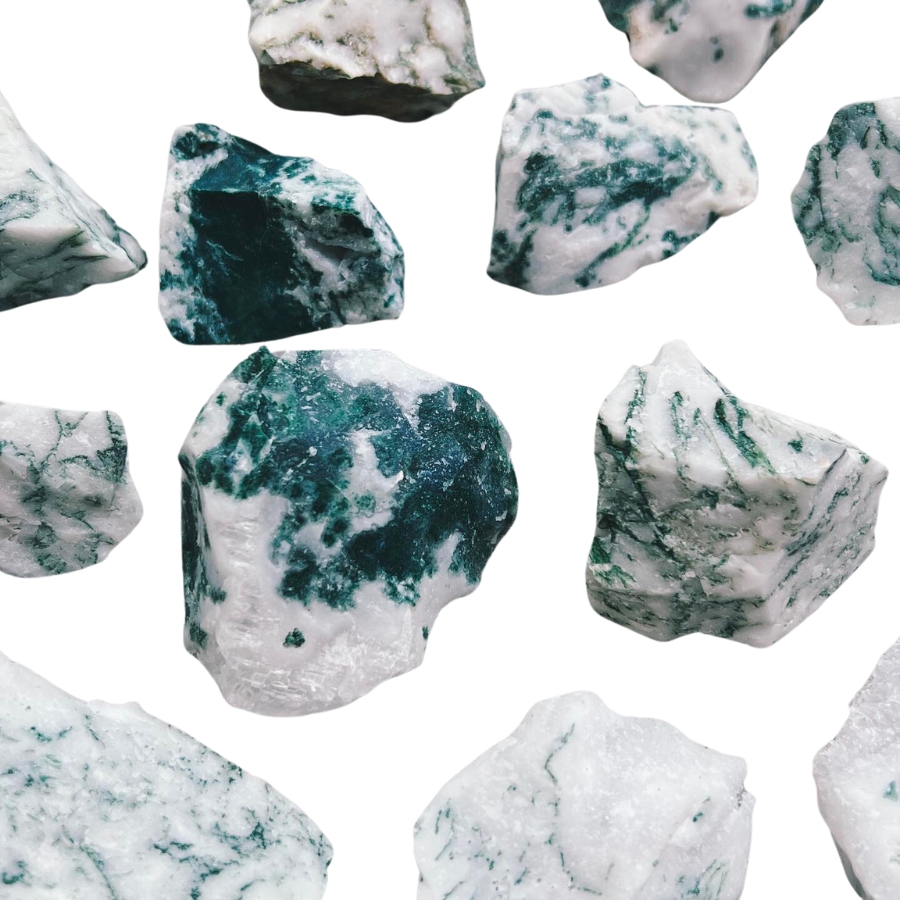
Tree agate, as its name suggests, looks like it’s got tiny trees or branches inside it. These tree-like patterns are usually green and spread out against a white or light gray background.
The green patterns aren’t actual trees, though. They’re made of minerals like chlorite or manganese.
Each piece of tree agate is different. You won’t find two that are exactly the same. It’s valued for its looks and it’s often used in jewelry and decorations.
The key factors in our recommendations are:
- The deep experience and understanding of our team about the area
- Recommendations from local groups and clubs
- How easy it is to get the a particular location
- Safety and potential hazards when collecting
- Weighing private and public locations
- The ability for both experienced and novice agate enthusiasts to find great samples
With these factors in mind we’ve been able to put together a fantastic list that just about anyone can use!
Kids. Beginners. Pros. Doesn’t matter. This book has become the go-to because it works for everyone.
Magy put it bluntly: “Identify rocks, crystals and minerals is so easy now!”
That’s not by accident, the photos are crisp, the callouts are simple, and the design is rugged enough to throw in a backpack without worrying. Whether it’s your first geode or your hundredth, this guide keeps the fun part simple: finding more treasures.
The Best Spots To Find Agates in North Dakota
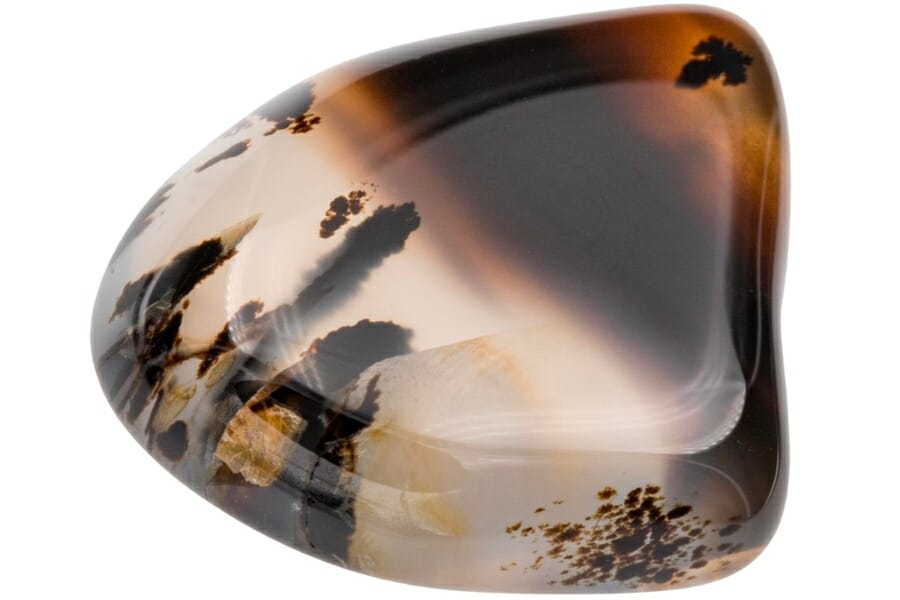
North Dakota is endowed with many great gem mine sites, but not all of them have agates. If you want to focus on finding these gems here, we highly recommend visiting and exploring the following prime spots:
Always Confirm Access and Collection Rules!
Before heading out to any of the locations on our list you need to confirm access requirements and collection rules for both public and private locations directly with the location. We haven’t personally verified every location and the access requirements and collection rules often change without notice.
Many of the locations we mention will not allow collecting but are still great places for those who love to find beautiful rocks and minerals in the wild without keeping them. We also can’t guarantee you will find anything in these locations since they are constantly changing.
Always get updated information directly from the source ahead of time to ensure responsible rockhounding. If you want even more current options it’s always a good idea to contact local rock and mineral clubs and groups
Turtle Mountain
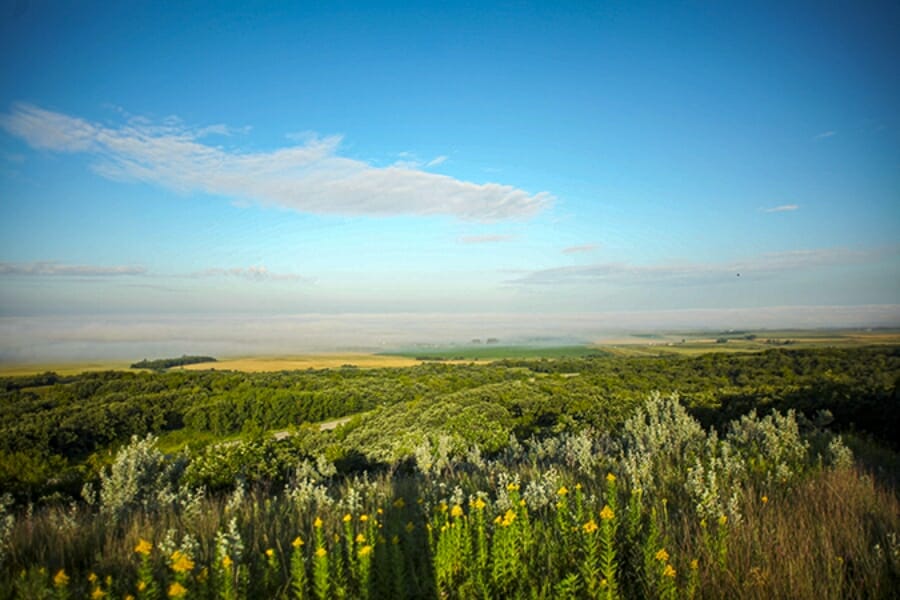
Turtle Mountain is a true gem for both nature and rock lovers. Located near the Canadian border, this area stands out with its gentle hills, lush forests, and beautiful lakes, making it distinct from the flatter terrains of the surrounding plains.
The mountains of this prime place aren’t towering peaks but are rather a series of rolling hills that rise unexpectedly from the landscape.
Geologically speaking, Turtle Mountain boasts a rich tapestry. It’s a result of glacial activity from thousands of years ago. As glaciers moved and receded, they deposited a variety of rocks and minerals in their wake, including agates.
This spot is well-connected by roads, and the nearby town of Bottineau serves as a convenient gateway for visitors. Just make sure that, before you head out here, you’re already familiar with North Dakota’s collecting guidelines.
What’s even better is that the region is well connected with roads, and it’s not too far from major cities like Louisville, so getting here is pretty easy. But before you head out, make sure to get familiar with the local collecting guidelines of Kentucky.
Where we found agates on Turtle Mountain
Explore the area gravels and pits of Turtle Mountain to find stunning samples of agates.
Hettinger County
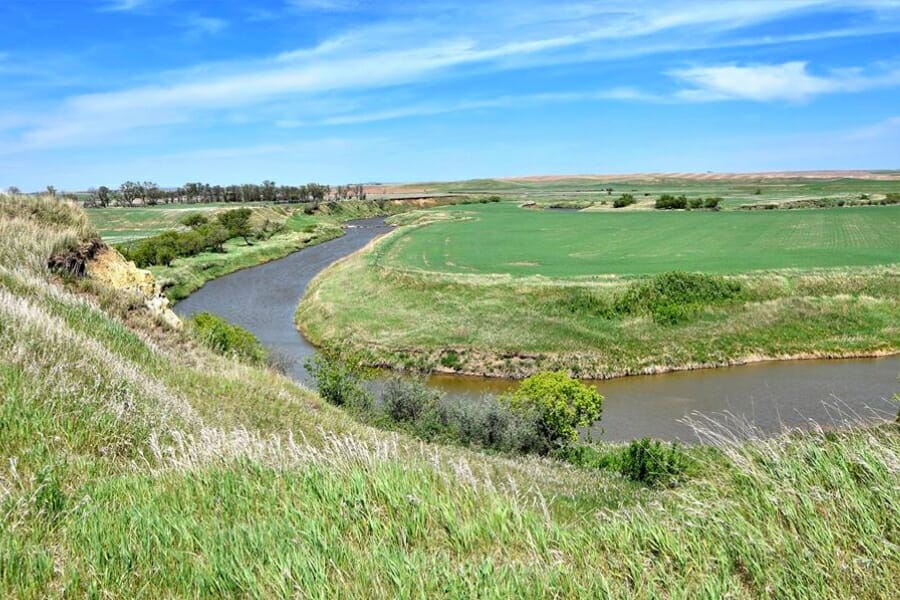
In Hettinger County, the beauty of the plains meets the thrill of geological exploration. With its sprawling grasslands that seem to stretch endlessly, it truly showcases the vastness of the North Dakota landscape.
From a geology perspective, this county has a lot to offer. Among the treasures here are agates, and Hettinger County provides ample opportunities for you to find them here. The conditions created by past glacial movements and the subsequent erosion processes have brought these gems closer to the surface.
Fortunately, reaching this prime place to find North Dakota agates is a breeze. Well-maintained roads crisscross the county. The town of Hettinger, which is the county seat, serves as a great starting point for any adventure here.
Where we found agates in Hettinger County
Among the many great sites where you can find agates in Hettinger County are the following:
- Cannonball River
- Both sides of Route 8 from Mott to Richardton
- Thirty Mile Creek
- Camel Buttes
Little Missouri River
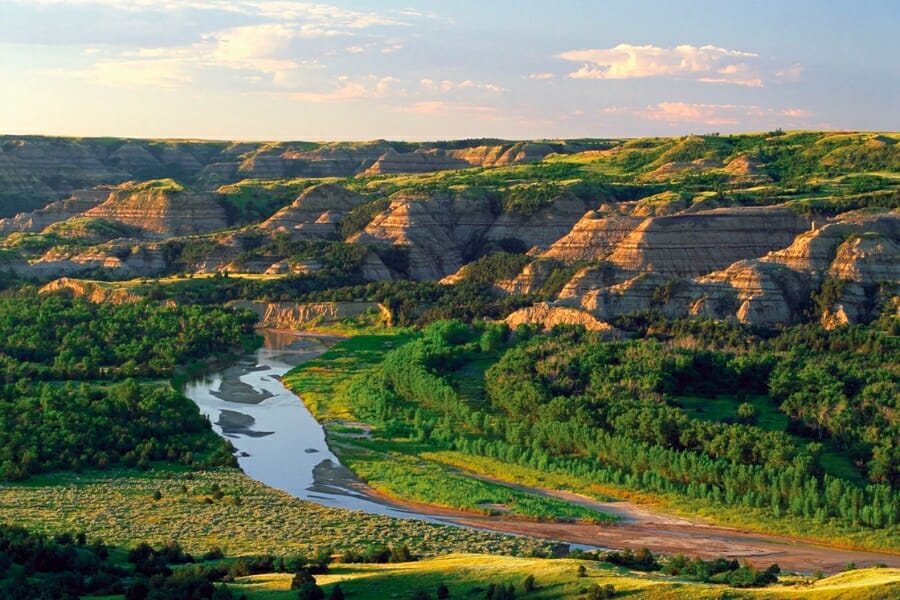
The Little Missouri River is a winding waterway that offers both scenic beauty and a playground for rock enthusiasts. Originating in the northeastern part of Wyoming, it flows northward through Montana and into North Dakota, eventually joining the Missouri River.
As the river snakes its way through our state, it carves out deep valleys and rugged badlands. These formations, with their layered rock faces and unique structures, give us a peek into the different natural wonders here.
The erosive action of the river has resulted in a plethora of rocks and minerals being accessible. Among these treasures is the much-sought-after agate.
If you want to go here, be assured that the Little Missouri River is accessible. There are several points, especially within the Theodore Roosevelt National Park, where you can easily access it.
Where we found agates in the Little Missouri River
You can find amazing Montana moss agate if you search through the gravels of the Little Missouri River in Grassy Butte.
Pembina County
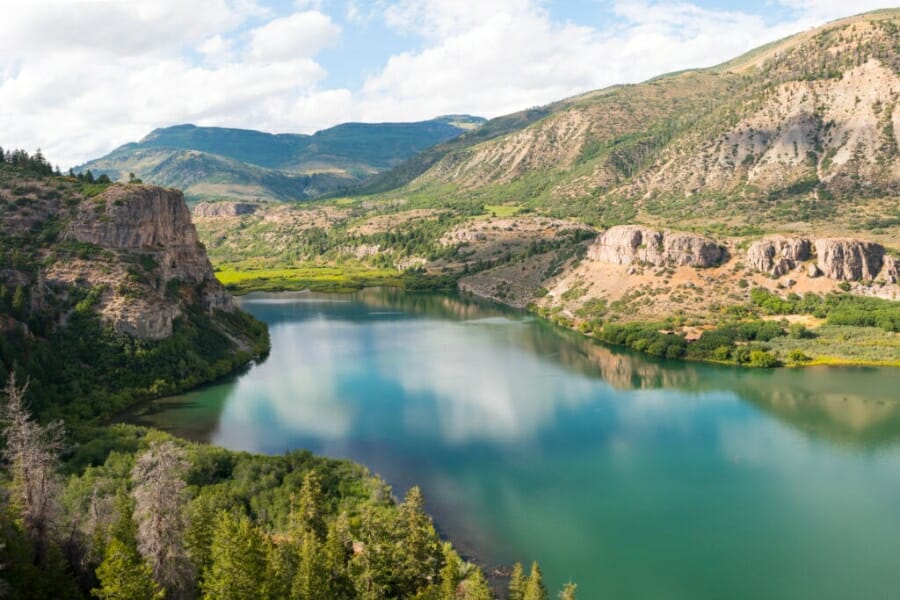
Pembina County, located in the northeastern corner of our state, touches the Canadian border and boasts of a landscape filled with flat plains and occasional gentle rolling hills. It’s an astounding agricultural heartland today.
But it’s not just crops that you can find here. The geology of this county is as rich as its soil. For the keen-eyed rockhound, its gravel pits and riverbanks might just reveal a beautiful treasure: North Dakota agates.
Going to Pembina County is a smooth ride. It’s well connected by roads, with Highway 29 running right through.
Where we found agates in Pembina County
Agate is quite abundant and widespread in Pembina County, and the following are some of the great places here where you can search for them:
- Concrete area of the abandoned limestone quarry
- Upstream along the west bank of the Red River to the mouth of the Pembina River
- Dry Lake in Webster area
- Sweetwater Lake
Heart River
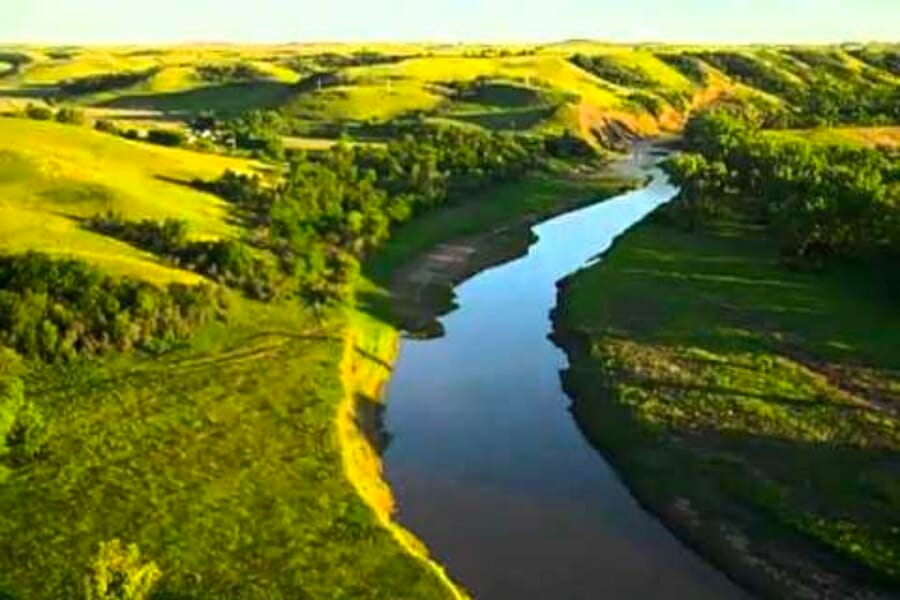
The Heart River is more than just a flow of water; it’s a journey through time and geology. Starting in the western part of our state, Heart River winds its way eastward until it meets the mighty Missouri River.
The terrain around the Heart River is quite a spectacle. It has steep valleys with layered rock formations, interrupted by open grasslands that sway with the wind.
If you want to visit, the river is accessible at several points, especially near towns like Dickinson and Mandan. Roads lead close to some of its most scenic spots, and there are places to pause, explore, or even have a picnic.
Where we found agates in the Heart River
You can find agates if you explore upstream and down along both sides of the Heart River.
Other Great Places To Find Agates in North Dakota
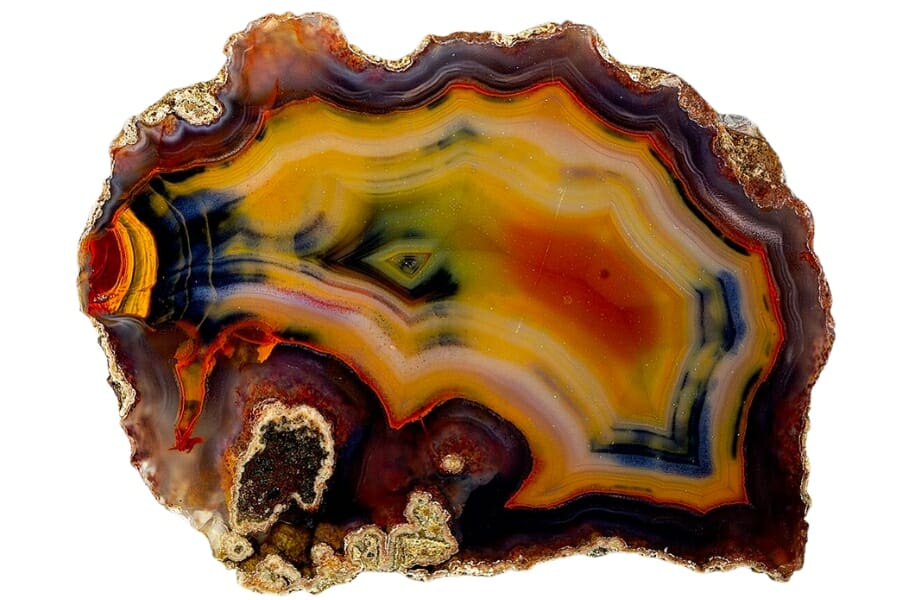
Aside from our top recommendations, there are plenty other prime places to find agates in North Dakota. We’ve listed them down by county below for your convenient reference.
Our recommendations by county
| County | Location |
| Billings | Area buttes and badlands formations in Medora |
| Burleigh | Missouri River |
| Grant | Cannonball River |
| Kidder | Regional gravel pits of Tappen |
| McKenzie | Yellowstone River |
| McKenzie | Confluence of the Missouri and Yellowstone rivers in East Fairview |
| McKenzie | Watford City area |
| Morton | Area hills, draws, and washes of Mandan |
| Ramsey | Devils Lake |
| Rolette | Dunseith area gravel pits |
| Stark | Area land surfaces of Dickinson |
| Stark | Large gravel pit in Route 22 |
| Ward | Souris River between Denbigh and Velva |
| Williams | Regional stream gravels |
Additional areas you can find agates
If you’ll be exploring a broad area, it can be hard to pinpoint where exactly to start your search. We recommend paying extra attention to the following spots where agates usually hide:
Rivers and River Banks
Rivers and their banks are nature’s conveyor belts for rocks and minerals. As water flows over time, it erodes the land and carries away smaller rocks and sediments.
The tougher rocks, like agates, often get trapped in gravel beds and along river banks. The water naturally polishes agates, making it even more noticeable.
The rivers in our state, like the Heart River and the Little Missouri River, have exposed many agates, revealing them for you to discover. So, when you’re near a river here, keep your eyes peeled!
Streams and Creeks
Streams and creeks are waterways that move and shape the land, often unearthing hidden gems along the way.
As water flows, it breaks down larger rocks, and the smaller, harder rocks, such as agates, end up getting caught in the streambeds and along the edges of creeks.
So, if you’re exploring a creek or a stream our state, be alert for these beautifully-banded stones. Beneath the water or resting on the banks, there might be a beautiful agate.
Sediment Deposits
Sediment deposits are like big, natural treasure chests for rock enthusiasts! Imagine all the tiny bits of rock, sand, and minerals that gather in one spot over time.
Agates are super strong, so while other rocks might break down, agates stay in one piece. Their colorful, wavy bands make them easy to spot in a mix of other sediments.
And guess what? North Dakota is a top spot for finding them in sediment deposits! Long ago, giant glaciers covered parts of our state. When they melted, they left behind a huge mix of materials, including agates. As wind and water moved these materials around, they settled in layers called sediments.
Common Agate-Hunting Questions
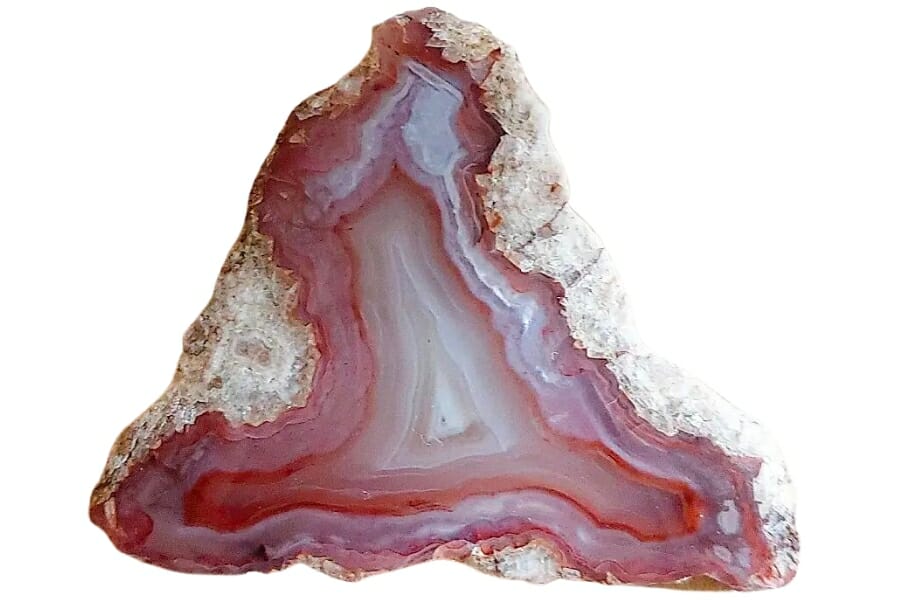
It might help to know the answers to the commonly-asked questions when it comes to agate hunting in North Dakota, so in this section, we’ll indulge you on that:
Is it illegal to collect agate in North Dakota?
In general, it’s legal to collect agates in areas of North Dakota that are considered designated collecting sites based on our state’s collecting guidelines.
As an additional rule, familiarize yourself with any area-specific environment and safety protocols to ensure your strict compliance with them.
The Best Places To Buy Agates In North Dakota

Not all agate lovers are adventure lovers, too, so if you prefer a more laid-back way of finding, observing, and taking home this gem, you can visit our local crystal shops here.
Below are some of the best ones that we have:
- Crystal Rock Healing – 923 W Interstate Ave, Bismarck, ND 58503
- Gnomes Nook – 14 8th St. Fargo, ND 58103
- Paul Broste Rock Museum – 508 Main St, Parshall, ND 58770
- Salt of the Earth – 44 Villard St W, Dickinson, ND 58601
- The Purple Door – 2001 8th Ave SE Suite D, Minot, ND 58703
- Treasures of Sea and Earth – 609 Memorial Hwy, Bismarck, ND 58504
If you have any recommendations for our list please leave a comment below!

